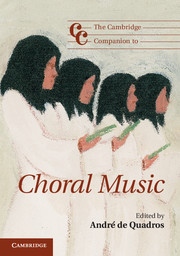Book contents
- Frontmatter
- 1 Introduction: choral music – a dynamic global genre
- Part I Choral music: history and context
- Part II Choral music the world over
- Part III Choral philosophy, practice, and pedagogy
- 15 Globalization, multiculturalism, and the children's chorus
- 16 Exploring the universal voice
- 17 Authentic choral music experience as “good work”: the practice of engaged musicianship
- 18 The making of a choir: individuality and consensus in choral singing
- 19 A point of departure for rehearsal preparation and planning
- 20 Small ensemble rehearsal techniques for choirs of all sizes
- Notes
- Select bibliography
- Index
- Cambridge Companions to Music
18 - The making of a choir: individuality and consensus in choral singing
from Part III - Choral philosophy, practice, and pedagogy
Published online by Cambridge University Press: 28 September 2012
- Frontmatter
- 1 Introduction: choral music – a dynamic global genre
- Part I Choral music: history and context
- Part II Choral music the world over
- Part III Choral philosophy, practice, and pedagogy
- 15 Globalization, multiculturalism, and the children's chorus
- 16 Exploring the universal voice
- 17 Authentic choral music experience as “good work”: the practice of engaged musicianship
- 18 The making of a choir: individuality and consensus in choral singing
- 19 A point of departure for rehearsal preparation and planning
- 20 Small ensemble rehearsal techniques for choirs of all sizes
- Notes
- Select bibliography
- Index
- Cambridge Companions to Music
Summary
A fundamental question facing any choir is how best to respect the individuality of each of its singers while getting them all to work together for the good of the group as a whole. In this sense, a choir is a microcosm of human social life. The voice is the most personal and individual form of human expression – we can recognize people within seconds by the sound of their voice alone. Yet when people join their voices together in a choir they cannot assert that full individuality without disrupting the communal voice of the collective.
Within the Western art tradition, it is generally seen as the conductor's job to manage the negotiations between the needs of the group as a whole and those of its individual members. John Bertalot, for example, tells directors:
At the beginning of a practice you have before you a collection of individuals. It's your job, within the first ten seconds of the practice, to weld them together into a choir – and a choir is a body of singers which feels a corporate sense of identity.
Joseph Lewis, meanwhile, puts it this way:
Team-work or what we call ensemble is more to be desired than outstanding voices, and the only possible way to obtain this “togetherness” is by the part being subservient to the whole; by each voice singing into the other voices, listening as well as singing, being content to be a strand in the rope, and not the whole rope, but all the while handing his or her contribution up to the conductor.
- Type
- Chapter
- Information
- The Cambridge Companion to Choral Music , pp. 256 - 271Publisher: Cambridge University PressPrint publication year: 2012
- 2
- Cited by



